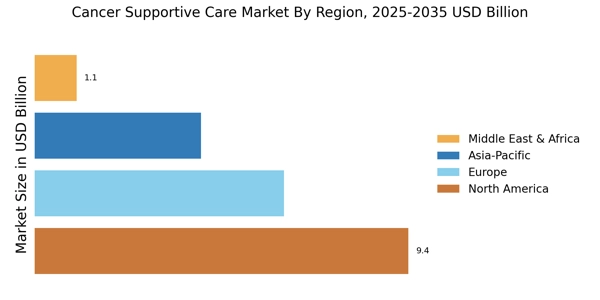Aging Population
The aging population is a critical factor driving the Cancer Supportive Care Market. As individuals age, the risk of developing cancer increases, leading to a higher prevalence of cancer among older adults. By 2030, it is estimated that the number of people aged 65 and older will reach 1.5 billion, many of whom will require cancer care and supportive services. This demographic shift necessitates a robust supportive care framework to address the unique needs of elderly cancer patients, including managing comorbidities and enhancing their quality of life. Consequently, healthcare providers are adapting their services to cater to this growing population, thereby propelling the Cancer Supportive Care Market forward.
Rising Incidence of Cancer
The increasing incidence of cancer worldwide is a primary driver for the Cancer Supportive Care Market. According to recent statistics, cancer cases are projected to rise significantly, with estimates suggesting that by 2040, the number of new cancer cases could reach 30 million annually. This alarming trend necessitates enhanced supportive care services to manage symptoms and improve the quality of life for patients. As the patient population grows, the demand for comprehensive supportive care solutions, including pain management, nutritional support, and psychological counseling, is likely to escalate. Consequently, healthcare providers are increasingly focusing on integrating supportive care into standard oncology practices, thereby expanding the Cancer Supportive Care Market.
Policy and Reimbursement Changes
Recent policy and reimbursement changes are significantly impacting the Cancer Supportive Care Market. Governments and insurance providers are increasingly recognizing the importance of supportive care in cancer treatment, leading to improved reimbursement policies for these services. This shift is encouraging healthcare providers to integrate supportive care into their treatment protocols, as financial barriers are reduced. Enhanced reimbursement for palliative care and supportive services is likely to increase access for patients, thereby driving demand within the Cancer Supportive Care Market. As policies continue to evolve, the landscape for supportive care is expected to become more favorable, promoting the growth of this essential sector.
Increased Awareness and Education
There is a notable increase in awareness and education regarding the importance of supportive care in cancer treatment, which is significantly influencing the Cancer Supportive Care Market. Patients, caregivers, and healthcare professionals are becoming more informed about the benefits of supportive care services, leading to higher demand. Educational initiatives and advocacy campaigns are playing a crucial role in disseminating information about the various supportive care options available, including palliative care and psychosocial support. This heightened awareness is likely to result in more patients seeking these services, thereby expanding the Cancer Supportive Care Market. Furthermore, as healthcare systems recognize the value of supportive care in improving patient outcomes, investments in these services are expected to increase.
Advancements in Treatment Modalities
Innovations in cancer treatment modalities, such as immunotherapy and targeted therapies, are reshaping the Cancer Supportive Care Market. These advanced treatments often come with complex side effects that require specialized supportive care. For instance, patients undergoing immunotherapy may experience unique challenges, including immune-related adverse events, which necessitate tailored supportive interventions. The growing complexity of cancer treatments is driving the need for multidisciplinary care teams that can address both the medical and psychosocial needs of patients. As a result, the Cancer Supportive Care Market is witnessing an increase in demand for services that complement these advanced therapies, ensuring that patients receive holistic care throughout their treatment journey.


















Leave a Comment